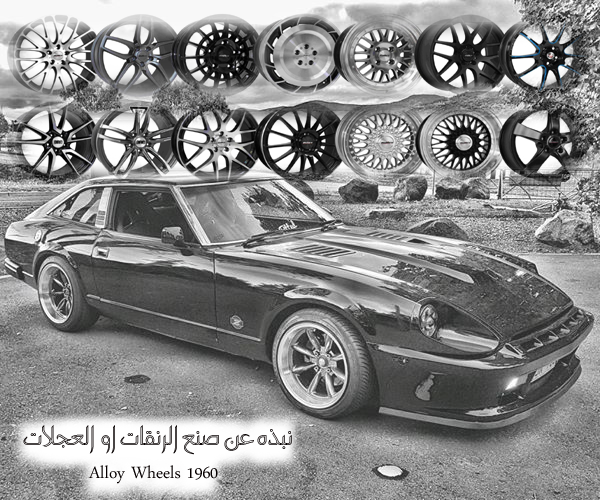عجلات العجلات هي عجلات مصنوعة من سبائك الألومنيوم أو المغنيسيوم. سبائك هي خليط من المعادن وغيرها من العناصر. أنها توفر عموما قوة أكبر على المعادن النقية، والتي عادة ما تكون أكثر ليونة وأكثر الدكتايل. سبائك الألومنيوم أو المغنيسيوم وعادة ما تكون أخف وزنا لنفس القوة، وتوفير أفضل توصيل الحرارة، وغالبا ما تنتج مظهر مستحضرات التجميل المحسنة على عجلات الصلب. على الرغم من أن الصلب، والمواد الأكثر شيوعا المستخدمة في إنتاج العجلات، هو سبيكة من الحديد والكربون، وعادة ما تكون عبارة "عجلة سبيكة" محفوظة لعجلات مصنوعة من سبائك غير الحديدية
وكانت أقرب عجلات خفيفة من سبائك مصنوعة من سبائك المغنيسيوم. على الرغم من أنها فقدت صالح على المركبات المشتركة، إلا أنها ظلت شعبية من خلال 1960s، وإن كان عدد محدود جدا. في منتصف الستينات من القرن الماضي، سمحت عمليات الصب بالألمنيوم بتصنيع عجلات أكثر أمانا لم تكن هشة. وحتى هذا الوقت، عانت معظم عجلات الألومنيوم من ليونة منخفضة، وعادة ما تتراوح من 2-3٪ استطالة. ولأن العجلات ذات السبائك الخفيفة في ذلك الوقت كانت غالبا ما تكون مصنوعة من المغنيسيوم (غالبا ما يشار إليها باسم "الخنازير")، فقد عزيت هذه العجالت في وقت مبكر عجلة إلى ليونة المغنيسيوم منخفضة، عندما في كثير من الحالات كانت العجلات عجلات سبائك الألومنيوم الزهر سيئة. وبمجرد اعتماد هذه التحسينات الصب الألومنيوم على نطاق أوسع، واستغرق عجلة الألومنيوم مكان المغنيسيوم منخفضة التكلفة وعالية الأداء عجلات لرياضة السيارات

Alloy wheels are wheels that are made from an alloy of aluminium or magnesium. Alloys are mixtures of a metal and other elements. They generally provide greater strength over pure metals, which are usually much softer and more ductile. Alloys of aluminium or magnesium are typically lighter for the same strength, provide better heat conduction, and often produce improved cosmetic appearance over steel wheels. Although steel, the most common material used in wheel production, is an alloy of iron and carbon, the term "alloy wheel" is usually reserved for wheels made from nonferrous alloys
The earliest light-alloy wheels were made of magnesium alloys. Although they lost favor on common vehicles, they remained popular through the 1960s, albeit in very limited numbers. In the mid-to-late 1960s, aluminum-casting refinements allowed the manufacture of safer wheels that were not as brittle. Until this time, most aluminum wheels suffered from low ductility, usually ranging from 2-3% elongation. Because light-alloy wheels at the time were often made of magnesium (often referred to as "mags"), these early wheel failures were later attributed to magnesium's low ductility, when in many instances these wheels were poorly cast aluminum alloy wheels. Once these aluminum casting improvements were more widely adopted, the aluminum wheel took the place of magnesium as low cost, high-performance wheels for motorsports
مقاطع فيديو
https://youtu.be/oISSonPjLOM
https://youtu.be/hnsvkpOP8_g
https://youtu.be/LCMs-7K8nLk
https://youtu.be/ZF_9LCcZoTM
سلامتكم
🖨 انسخ الصفحه
وكانت أقرب عجلات خفيفة من سبائك مصنوعة من سبائك المغنيسيوم. على الرغم من أنها فقدت صالح على المركبات المشتركة، إلا أنها ظلت شعبية من خلال 1960s، وإن كان عدد محدود جدا. في منتصف الستينات من القرن الماضي، سمحت عمليات الصب بالألمنيوم بتصنيع عجلات أكثر أمانا لم تكن هشة. وحتى هذا الوقت، عانت معظم عجلات الألومنيوم من ليونة منخفضة، وعادة ما تتراوح من 2-3٪ استطالة. ولأن العجلات ذات السبائك الخفيفة في ذلك الوقت كانت غالبا ما تكون مصنوعة من المغنيسيوم (غالبا ما يشار إليها باسم "الخنازير")، فقد عزيت هذه العجالت في وقت مبكر عجلة إلى ليونة المغنيسيوم منخفضة، عندما في كثير من الحالات كانت العجلات عجلات سبائك الألومنيوم الزهر سيئة. وبمجرد اعتماد هذه التحسينات الصب الألومنيوم على نطاق أوسع، واستغرق عجلة الألومنيوم مكان المغنيسيوم منخفضة التكلفة وعالية الأداء عجلات لرياضة السيارات

Alloy wheels are wheels that are made from an alloy of aluminium or magnesium. Alloys are mixtures of a metal and other elements. They generally provide greater strength over pure metals, which are usually much softer and more ductile. Alloys of aluminium or magnesium are typically lighter for the same strength, provide better heat conduction, and often produce improved cosmetic appearance over steel wheels. Although steel, the most common material used in wheel production, is an alloy of iron and carbon, the term "alloy wheel" is usually reserved for wheels made from nonferrous alloys
The earliest light-alloy wheels were made of magnesium alloys. Although they lost favor on common vehicles, they remained popular through the 1960s, albeit in very limited numbers. In the mid-to-late 1960s, aluminum-casting refinements allowed the manufacture of safer wheels that were not as brittle. Until this time, most aluminum wheels suffered from low ductility, usually ranging from 2-3% elongation. Because light-alloy wheels at the time were often made of magnesium (often referred to as "mags"), these early wheel failures were later attributed to magnesium's low ductility, when in many instances these wheels were poorly cast aluminum alloy wheels. Once these aluminum casting improvements were more widely adopted, the aluminum wheel took the place of magnesium as low cost, high-performance wheels for motorsports
مقاطع فيديو
https://youtu.be/oISSonPjLOM
https://youtu.be/hnsvkpOP8_g
https://youtu.be/LCMs-7K8nLk
https://youtu.be/ZF_9LCcZoTM
سلامتكم
📂: القسم
مواضيع مصابن الكويت
